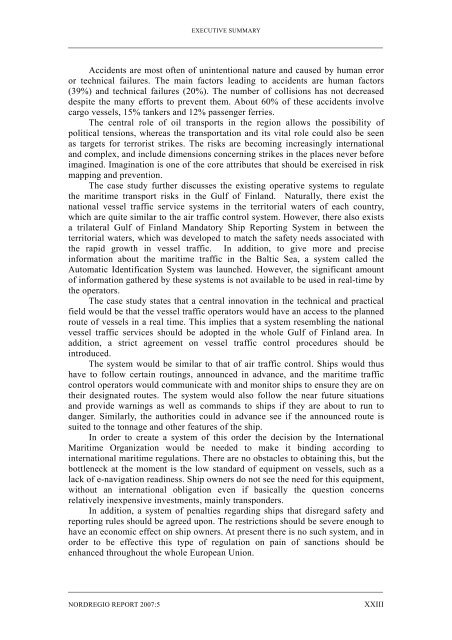Towards a Baltic Sea Region Strategy in Critical ... - Helsinki.fi
Towards a Baltic Sea Region Strategy in Critical ... - Helsinki.fi
Towards a Baltic Sea Region Strategy in Critical ... - Helsinki.fi
You also want an ePaper? Increase the reach of your titles
YUMPU automatically turns print PDFs into web optimized ePapers that Google loves.
EXECUTIVE SUMMARY<br />
Accidents are most often of un<strong>in</strong>tentional nature and caused by human error<br />
or technical failures. The ma<strong>in</strong> factors lead<strong>in</strong>g to accidents are human factors<br />
(39%) and technical failures (20%). The number of collisions has not decreased<br />
despite the many efforts to prevent them. About 60% of these accidents <strong>in</strong>volve<br />
cargo vessels, 15% tankers and 12% passenger ferries.<br />
The central role of oil transports <strong>in</strong> the region allows the possibility of<br />
political tensions, whereas the transportation and its vital role could also be seen<br />
as targets for terrorist strikes. The risks are becom<strong>in</strong>g <strong>in</strong>creas<strong>in</strong>gly <strong>in</strong>ternational<br />
and complex, and <strong>in</strong>clude dimensions concern<strong>in</strong>g strikes <strong>in</strong> the places never before<br />
imag<strong>in</strong>ed. Imag<strong>in</strong>ation is one of the core attributes that should be exercised <strong>in</strong> risk<br />
mapp<strong>in</strong>g and prevention.<br />
The case study further discusses the exist<strong>in</strong>g operative systems to regulate<br />
the maritime transport risks <strong>in</strong> the Gulf of F<strong>in</strong>land. Naturally, there exist the<br />
national vessel traf<strong>fi</strong>c service systems <strong>in</strong> the territorial waters of each country,<br />
which are quite similar to the air traf<strong>fi</strong>c control system. However, there also exists<br />
a trilateral Gulf of F<strong>in</strong>land Mandatory Ship Report<strong>in</strong>g System <strong>in</strong> between the<br />
territorial waters, which was developed to match the safety needs associated with<br />
the rapid growth <strong>in</strong> vessel traf<strong>fi</strong>c. In addition, to give more and precise<br />
<strong>in</strong>formation about the maritime traf<strong>fi</strong>c <strong>in</strong> the <strong>Baltic</strong> <strong>Sea</strong>, a system called the<br />
Automatic Identi<strong>fi</strong>cation System was launched. However, the signi<strong>fi</strong>cant amount<br />
of <strong>in</strong>formation gathered by these systems is not available to be used <strong>in</strong> real-time by<br />
the operators.<br />
The case study states that a central <strong>in</strong>novation <strong>in</strong> the technical and practical<br />
<strong>fi</strong>eld would be that the vessel traf<strong>fi</strong>c operators would have an access to the planned<br />
route of vessels <strong>in</strong> a real time. This implies that a system resembl<strong>in</strong>g the national<br />
vessel traf<strong>fi</strong>c services should be adopted <strong>in</strong> the whole Gulf of F<strong>in</strong>land area. In<br />
addition, a strict agreement on vessel traf<strong>fi</strong>c control procedures should be<br />
<strong>in</strong>troduced.<br />
The system would be similar to that of air traf<strong>fi</strong>c control. Ships would thus<br />
have to follow certa<strong>in</strong> rout<strong>in</strong>gs, announced <strong>in</strong> advance, and the maritime traf<strong>fi</strong>c<br />
control operators would communicate with and monitor ships to ensure they are on<br />
their designated routes. The system would also follow the near future situations<br />
and provide warn<strong>in</strong>gs as well as commands to ships if they are about to run to<br />
danger. Similarly, the authorities could <strong>in</strong> advance see if the announced route is<br />
suited to the tonnage and other features of the ship.<br />
In order to create a system of this order the decision by the International<br />
Maritime Organization would be needed to make it b<strong>in</strong>d<strong>in</strong>g accord<strong>in</strong>g to<br />
<strong>in</strong>ternational maritime regulations. There are no obstacles to obta<strong>in</strong><strong>in</strong>g this, but the<br />
bottleneck at the moment is the low standard of equipment on vessels, such as a<br />
lack of e-navigation read<strong>in</strong>ess. Ship owners do not see the need for this equipment,<br />
without an <strong>in</strong>ternational obligation even if basically the question concerns<br />
relatively <strong>in</strong>expensive <strong>in</strong>vestments, ma<strong>in</strong>ly transponders.<br />
In addition, a system of penalties regard<strong>in</strong>g ships that disregard safety and<br />
report<strong>in</strong>g rules should be agreed upon. The restrictions should be severe enough to<br />
have an economic effect on ship owners. At present there is no such system, and <strong>in</strong><br />
order to be effective this type of regulation on pa<strong>in</strong> of sanctions should be<br />
enhanced throughout the whole European Union.<br />
NORDREGIO REPORT 2007:5<br />
XXIII

















